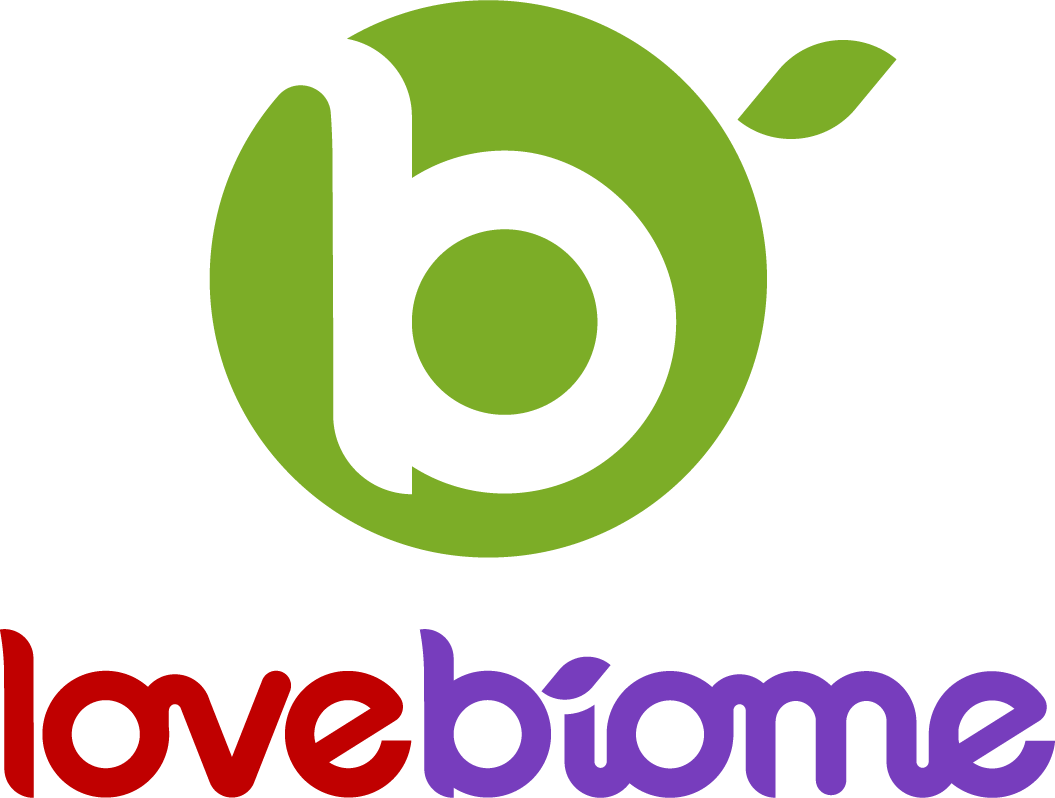Gut Health Essentials: Prebiotics, Probiotics, and Postbiotics
By: Zach Aanderud Ph.D.
This article defines the three biotics and emphasizes the interconnectedness of the biotics and their health benefits in the gut microbiome. Includes a deeper dive into the fundamentals of pre, pro, and postbiotics and the interactions between these three distinct categories. Highlights the pre, post, and probiotics in LoveBiome products with relatively short descriptions for key products.
As we search for truths to digest the importance of our microbiomes, we are often barraged by three terms: prebiotics, probiotics, and postbiotics. The three terms are directly related to our microbiomes or the “collection of all microbes, such as bacteria, fungi, viruses, and their genes, that naturally live on our bodies and inside us” as defined by the National Institute of Health of the United States of America (https://www.niehs.nih.gov/health/topics/science/microbiome/index.cfm#:~:text=The%20microbiome%20is%20the%20collection,to%20human%20health%20and%20wellness.).
However, our understanding of pre, pro, and postbiotics can often get muddled. Blogs, tweets, and industry publications use the three terms interchangeably without distinction, using medical jargon to loosely define hundreds of different living and nonliving components in health products. Further exacerbating the confusion is the flood of pre, pro, and/or postbiotics products on the market touting multiple health benefits often leaving consumers confused and overwhelmed when trying to select products.
Unfortunately, the pre, pro, and/or postbiotics products we as disoriented consumers select may perform poorly and sour us on microbiome health, creating a perception that the entire industry is just “snake oil” when nothing could be further from the truth. Only when we clearly understand the distinction and importance of pre, pro, and postbiotics will we, the consumer, be able to truly harness the power of balanced microbiomes.

To help illustrate the importance of pre, pro, and postbiotics in microbiomes, we will use a vital ecosystem service, pollination, as an analogy. Pollination is essential to the survival of 88% of flowering plants, sustains 35% of the global plant-based food supply, and contributes $195 – $387 billion US to us annually free of charge (Porto et al 2020). Just like pollination, microbiomes are incredibly widespread, existing in all 8 billion of us, and help us digest our food, regulate our immune systems, protect against disease-causing pathogens, influence our moods, and produce vitamins all for free.
The term “probiotic” is derived from the Greek meaning “for life” and was coined by Daniel Lilley and Rosalie Stillwell in 1965 (Lilley and Stillwell 1965) to convey the exact opposite meaning of “antibiotic” and later refined to focus specifically on benefits to the host. A probiotic is a live microorganism that, when administered in adequate amounts, confers a health benefit to the host (Vinderola et al 2022). In our pollination analogy pollinators are like probiotics. Pollinators worldwide consist of over 15,000 species of predominantly bees, wasps, beetles, moths, bats, and birds. Similarly, probiotics are the living microorganisms, generally bacteria species, present in the food we eat of the supplements we purchase that improve our health. Generally, probiotics are from seven core bacterial genera most often used in commercial products including Lactobacillus, Bifidobacterium, Saccharomyces, Streptococcus, Enterococcus, Escherichia, and Bacillus (https://ods.od.nih.gov/factsheets/Probiotics-HealthProfessional/). Hundreds of species are marketed as probiotics. For example, Lactobacillus species are common probiotics with over 170 species and 17 subspecies in its genera (Goldstein et l 2015).
Probiotics are just a small part of your microbiomes. Generally, human microbiomes are dominated by bacteria that consist of trillions of single cells and thousands of bacterial species. Of these thousands of bacterial species, most are beneficial and symbiotic, classified as commensal or mutualistic bacteria, providing the host, us, with essential nutrients through digestion and defending us against opportunistic pathogens, while receiving food and a relatively stable environment. Fewer species in our microbiomes are probiotics, ingested intentionally in our food or as supplements, to provide a myriad of direct health benefits to the host.
Last, only a small fraction of your microbiome are species considered pathogenic in a healthy person and are considered “bad” bacteria. Your microbiome, and the probiotic species within them, may fluctuate daily, weekly, and/or monthly depending on your diet, supplement use, medication, exercise, and a host of other environmental exposures (Rinninella et al 2019)
As for prebiotics, pollination is a mutually beneficial interaction where the pollinators are rewarded with food—nectar and pollen—for visiting a flower. The nectar and pollen rewards are like prebiotics in our analogy. Prebiotics are relatively chemically complex “foods” that feed the beneficial and probiotic bacteria conferring a health benefit to the host (Vinderola et al 2022). Prebiotics come in tons of different chemical forms depending on the probiotics that we are attempting to nourish in a specific microbiome. Prebiotics may feed multiple species of probiotics or may feed only a specific species of probiotics creating a unique syntropy.

We see this same phenomenon with pollination, where specific species of pollinators specialize or visit only certain flower species. The pairings of prebiotic and probiotic combinations to enhance human health is called synbiotics, first proposed by Gibson and Roberfroid in 1995 to explain direct interactions between biotics in the human gut microbiome. Regardless, in all human microbiomes (e.g., vaginal, skin, eye, ear, nasopharyngeal tract, mouth, and gastrointestinal tract), prebiotics are often found in plants located within family gardens, exotic spice markets, exotic and wild areas, and ancient sources—plant life gives life.
The last component of our analogy is the postbiotics. Continuing our analogy, and borrowing an example from the most prolific pollinator on the planet, the honeybee, postbiotics can be compared to the honey that feeds the hive. Bees enzymatically alter and process nectar from flowers, just as probiotics and beneficial bacteria in our microbiomes, enzymatically alter prebiotics into postbiotic during metabolism. Specifically, postbiotics are not just the waste left behind after bacteria finish feeding but a heterogeneous mixture of cellular structures from lysing or dead bacteria and metabolites that provide a direct health benefit to the host (Rinninella et al 2019). Examples of postbiotics include beneficial bioactive chemicals like short-chain fatty acids (SCFA); digestive enzymes; bacteriocins with antimicrobial activities; amino acids; vitamins such as thiamine, riboflavin, B12, and K; and neuroactive compounds just to name a few.
Ultimately, you decide the prebiotics, probiotics, and postbiotics that influence your microbiomes. We encourage you to love your microbiomes by embracing a wide variety of prebiotic flowers, assembling a diverse array of probiotic pollinators, and benefiting from the sweet postbiotics that nourish your hive.
For a huge array of prebiotics, probiotics, and postbiotics, try a LoveBiome complete pack today!

About the Author
Zach Aanderud holds a Ph.D. and is a professor of microbial ecology and biogeochemistry at Brigham Young University. He was born and raised in Portland, Oregon, and was educated at BYU, the University of California Davis, and Michigan State University.
References
Porto RG et al (2020) Pollination ecosystem services: a comprehensive review of economic values, research funding and policy actions. Food Security 12. DOI: 10.1007/s1257-020-01043-w
Lilly DM and Stillwell RH (1965) Probiotics: growth promoting factors produced by microorganism. Science 147:3659. DOI: 10.1126/science.147.3659.7. DOI: 10.3390/foods11081077
Vinderola G, Sanders ME, Salminen S (2022) The concept of postbiotics. Foods 11(8): 1077. DOI: 10.3390/foods11081077
Rinninella E. et al. (2019) What is the healthy gut microbiota composition? A changing ecosystem across age, environment, diet, and diseases. Microorganisms 7:14. DOI: 10.3390/microorganisms7010014
Gibson and Roberfroid (1995) Dietary modulation of the human colonic microbiota: introducing the concepts of prebiotics. Journal of Nutrition 125(6). DOI: 10.1093/jn/125.6.1401
Goldstein EJC, Tyrell KL, Citron DM (2015) Lactobacillus species: taxonomic complexity and controversial susceptibilities. Clinical Infectious Diseases 60:2. DOI: 10.1093/cid/civ072






